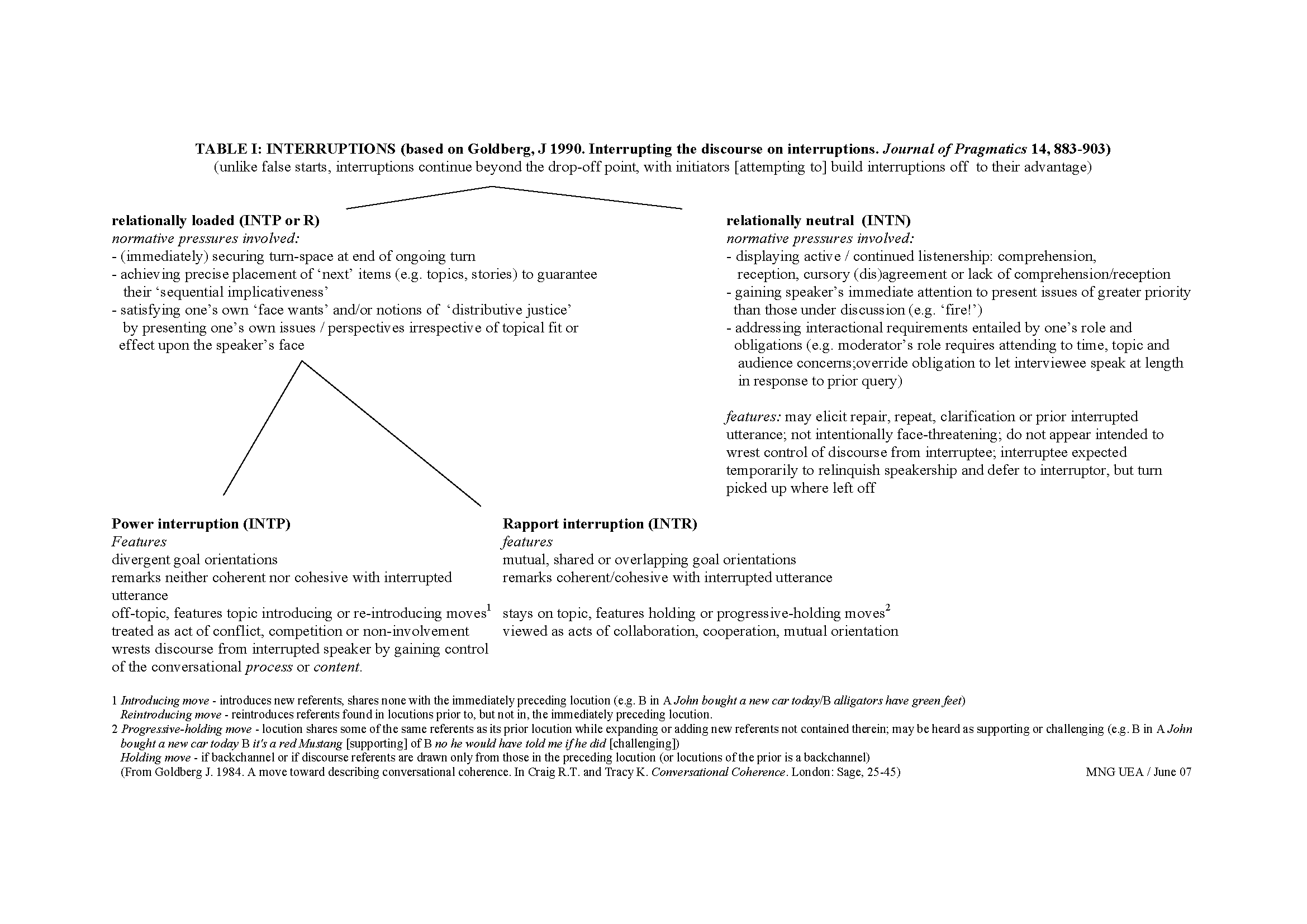UEA Corpus
Transcription Conventions
The data were reformatted to adhere to the CHILDES transcription conventions.
Additional conventions: Interruptions and types of interruptions
Interruptions are generally deemed violations of current speakers' rights, but there is no general consensus about their definition, identification and classification - still a highly contentious and complex question (see Guillot M.-N. 2005: Revisiting the debate on interruptions: from measurement to classification in the annotation of data for cross-cultural research. Pragmatics 15; 1, 25-47).
For the purposes of the project for which the data were collected. the data were coded using the scheme described below (see also Guillot 2005, as above).
Identification
The scheme differentiates between overlaps and interruptions, to account for violations of speakers' rights not involving an overlap. Such non-overlapped violations of speakers' rights are overlooked in qualitatively-driven approaches advocating dealing with overlaps, as observable phenomena, rather than with interruptions, whose identification is deemed to involve value judgements (e.g. Drummond 1989, Tannen 1994; see references at the end of this section).
Interruptions are defined as a function of utterance incompleteness, judged on the basis of unequivocal breaks in the previous speaker's last uttered word, in the syntax of the previous speaker's utterance and/or in the unit of meaning developed by the previous speaker.
Interruptions are differentiated from false starts, coded [^ gui: startFalse] [^ gui: endFalse] in the data, i.e. turn or potential interruption dropped immediately at or before the initial drop point (from Goldberg 1990; see below).
Classification
The classification scheme is based on Goldberg's 1990 scheme (see references at the end of this section). Goldberg differentiates between the following different types of interruptions (also differentiated from false starts (see above).
- (affiliative) relationally neutral interruptions, i.e. arising from the listener's participatory rights and obligations (addressing immediate communicative needs, e.g. eliciting repairs - coded [^ gui: INTN] in the data;
- (non-affiliative) relationally loaded interruptions, i.e. the by-product of the listener's participatory wants, further subdivided into:
- rapport interruptions (with overlapping goal orientations, viewed as cooperative acts - coded [^ gui: INTR] in the data
- power interruptions (with divergent goal orientations, viewed as acts of conflict - coded [^ gui: INTP] in the data
The first step in Goldberg's categorisation is
- a) to identify type of interactional pressure (as above).
It is then guided by
- b) the type of interruptive act, defined with the set of operational criteria detailed in Table 1 below;
- c) the response to the interruptive act.
Goldberg's approach is, in the CA tradition, governed by situated analysis and members' response, thus involves interpretation. Part of her categorisation (i.e. a) and b) above) is largely independent of members' response and gives scope for 'objective' coding.
The project for which the data were collected is interested in the tension between interruptive phenomena as identified by operational criteria and responses to interruptive acts (see Guillot 2005). The coding is accordingly based on a) and b) of Goldberg's scheme; c) is considered in qualitative analyses of the data and not represented in the coding.
Other transcription conventions
[^ gui: SIM] - simultaneous turn-taking
[^ COM: xxx] e.g. [^ COM: laugh] - additional information about a turn or set of turns, here comment about a subject laughing
References
Drummond K. 1989. A backward glance at interruptions. Western Journal of Speech Communication 53: 150-66.
Goldberg J. 1983. A move towards describing conversational coherence. In R.T. Craig and Tracy K. (eds). Conversational coherence: form, structure and strategy. London: Sage, 22-45.
Goldberg J. 1990. Interrupting the discourse on interruptions: an analysis in terms of relationally neutral, power and rapport oriented acts. Journal of Pragmatics 14: 883-903.
Tannen D. 1994. Gender and discourse. Oxford: Oxford University Press.



